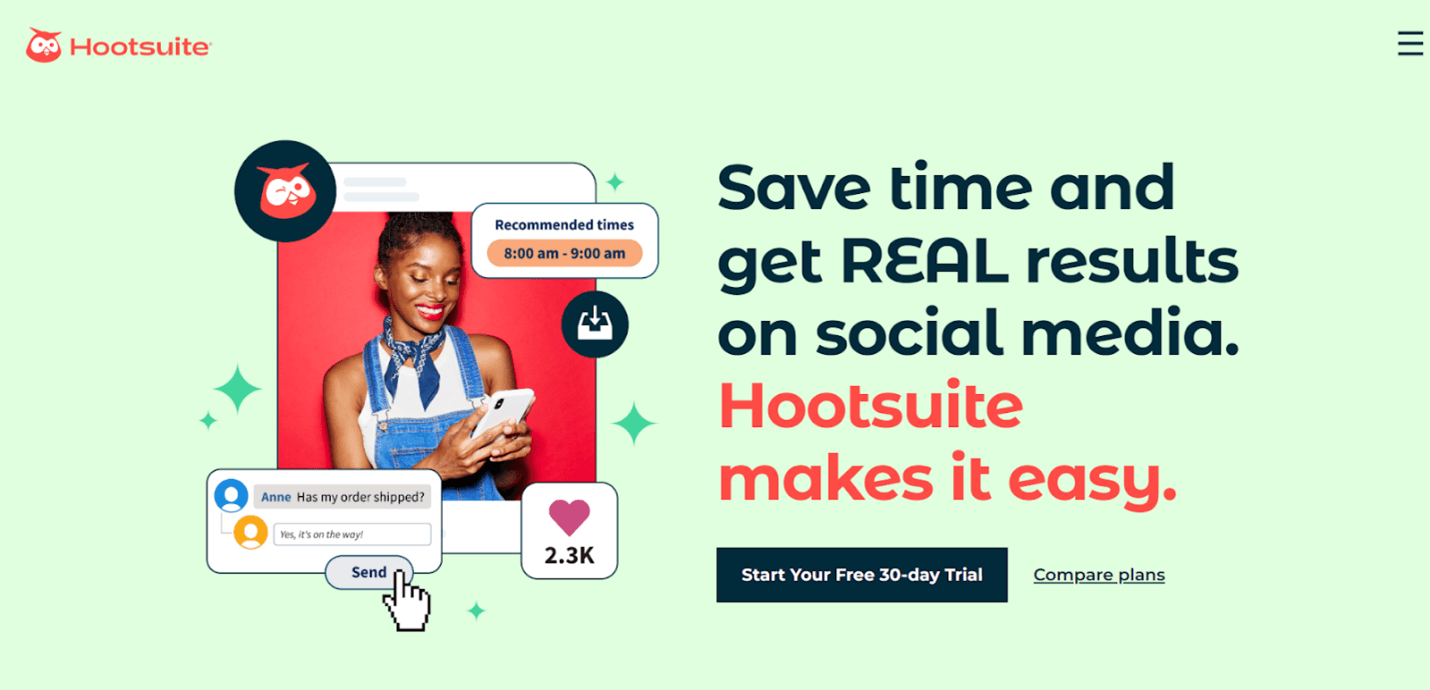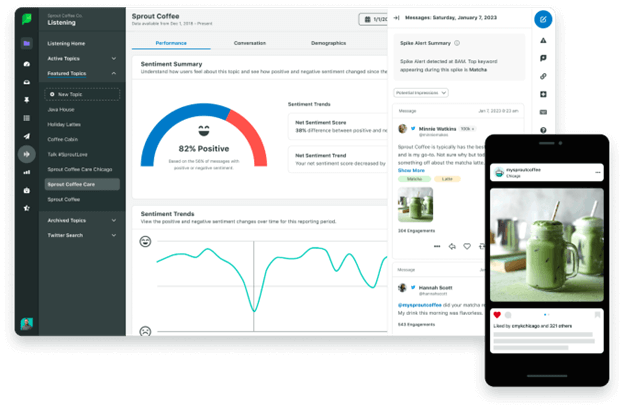Marketing and selling SaaS is anything but straightforward.
There is no tangible product a customer can see and examine, for starters. It can be challenging to show customers the benefits the tool will give their operations in time or test out one of the most crucial aspects — integrations.
Many SaaS companies struggle to come up with SEO strategies that stick with their target audience or result in conversions. If you’re looking to revamp your SEO efforts to see quality and growth in your business, we’ve just the tool guide for you.
We bring you some easy and actionable steps that will help you master your SaaS marketing strategies to grow your brand in 2024. Let’s dive in.
Master the SaaS marketing strategies to grow your brand in 2024
Since SaaS products are not tangible and have their presence entirely online, marketing and SEO are of exponential value to put your product out there and get people to use it. SEO plays an important role in promoting a software and building a positive presence around it.
Your end goal with your marketing efforts is to generate awareness about the product, generate authentic leads, and eventually get conversions. But how do you do this when there is no tangible product to hold and show to people?
In this guide, we will focus on breaking down your marketing and SEO efforts and building them from the ground up. This includes breaking down your product in terms of its functions and benefits and marketing it based on the value it gives to users.
We will further that by creating stellar content around it that showcases the many benefits it gives to users. There are many innovative ways to go about it but you need to choose the ones that best suit your budget and vision.
1.Get a grip on your product and market
The first step in creating a stellar marketing campaign for your software solutions is defining the product at hand.
It may seem like a given but many companies miss the mark by doing what is getting traction at the moment instead of checking first if it works for their product or not.
This SaaS SEO guide by Skale goes in-depth about getting a firm grip on your product and the market you intend to target as it sets a strong foundation for your marketing campaigns.
It helps you with data-driven decision-making as you make more informed and educated decisions based on the information you have about your own product.
There are three major facets you need to explore to create the foundation of your marketing and SEO:
Launching the product
Knowing the core and foundation of your product makes it easier for you to market it. You understand the ins and outs of it to explain to the next person in the most pointed way why they need it.
Ask questions such as what is it? What does it do? And what are its benefits? There are three aspects you need to highlight when analyzing your product:
- its USP,
- use cases,
- and pain points it solves.
USP is the point at which you sell the product.
What makes it unique in the market?
What does it have that its competitors don’t?
This lets the customers know the value they are getting with your product that they aren’t with your competitors.
But don’t stop there.
Create as many used cases as you can for the product. List out every single way your service can be used and how the consumers can get the most out of it. This allows the user to visualize themselves using the service/how they can put it to use.
The more use cases you have, the more pointers you create to market the product. You can dedicate different campaigns to single use cases. Lastly, focus on the pain point of the customer you aim to solve with your product.
It will be the basis of your forming a connection with your audience. Let them know you understand their struggle and are here to solve it. Empathize with them and highlight why they need your product.
A product launch checklist can be particularly help in this case for several reasons:
i) Ensures thorough preparation by covering all the necessary tasks and considerations involved in a product launch
ii) Fosters coordination, prevents miscommunication, and enhances overall efficiency
iii) Helps you manage your time effectively and minimizes risks of delays
iv) Acts as a safeguard against errors and omissions
v) Enhances consistency and quality by maintaining high level of quality and professionalism throughout the launch
vi) Serves as a reference point for future launches and enables continuous improvement
Understanding your target audience
Once you get a handle on your product, look to define the market you intend to target. This can only be done once you’ve defined the product as you will understand better now who is it meant for.
This simply means defining the demographics of the target audience, such as:
- Age
- Gender
- Occupation
- Culture
- Geographic location
- Interests
An advantage SaaS products have over tangible products is that you can potentially reach all over the world with your marketing and gain authentic leads. Narrowing the demographics of your audience helps you target users more pointedly.
Based on this, you may create buyer personas.
56% of companies say that they are able to generate high-quality leads with the use of buyer personas. Doing so will help you visualize the kind of people that would be interested in your product and target them effectively.
Another way to go about this is to determine where they stand on the sales funnel. This helps you decide which kinds of marketing tactics you should use on them. Say, if they’re at the top of the funnel, you need to make them aware of your brand and product.
The goal of understanding your target audience is to cater to them accordingly. Get to know them and personalize your efforts based on their likes, dislikes, and what they need to solve their pain points.
Defining your SEO goals
The next step after you’ve defined your product and your audience is to define your marketing goals with them.
Set up KPIs regarding what you want to achieve in a given period of time. Your goals should be achievable and specific.
SMART (Specific, Measurable, Achievable, Relevant, and Time-Bound) goals give a much clearer idea of what needs to be done. For example, your goal could be to spread awareness on social media about your product.
For this, you should set KPIs in a specific follower count, engagement in posts, and perhaps mentions on the platform. Your marketing efforts will then be directed toward achieving those specific goals.
2. Optimize your website
Your website is the center of your existence online. It becomes even more important for businesses such as SaaS that are entirely online. It is what all your marketing efforts will be directed to.
You need to make sure that your website is one that attracts and engages users. Make it a one-stop shop i.e., the place that provides complete information to users regarding your product and makes them consider you.
An excellent example of this is the website of Hootsuite. It has the following elements that make it stand out and engage users instantly:
Pleasing design and colors
The website took a combination of colors that are associated with its logo and some that contrast it to create a beautiful layout that is pleasing to the eye and pulls you right in.
Not text-heavy
The design is minimal and not at all text-heavy. But that doesn’t mean it compromises on what it wants to convey. It just gets right to the point without beating around the bush.Landing pages with more than 800 words have a 33% lower conversion rate than pages that have 200 words or less.
Takes you on a journey
The website starts with what it will do for you and then takes you on a journey of how to use it for the best results. It tells exactly how it will help you achieve success, enticing you in.
Lists interesting case studies
It mentions an interesting case study of helping a brand achieve success and invites you to learn how. This helps users see the actionable, tangible steps Hootsuite took to help that client and can also help them.
Tells you how to get started
This is the most important element that helps Hootsuite’s website stand out. It tells you what you need to do right now to get started, clearing your doubts and inviting you in.
3. Get people to try our your product
The most helpful way to get people interested in your SaaS offering is to let them try it. Let them see what you have to offer and how they can achieve success with it. It also shows confidence in your product that you’re willing to let people decide for themselves.
The hope here is that once the user starts using your offering, they cannot stop using it. That they would want to continue using it. Or if they don’t continue their subscription, they might come back after spending some time without your service and seeing its value.
As you get people to try out your offering, there are three things to keep in mind:
Be clear about your price
Don’t beat around the bust when it comes to price. Many SaaS companies hide the price, making users take extra steps of contacting them to reveal it. This only discourages users from giving you a chance.
First, they would have to take the extra steps of contacting you and possibly explaining their business needs to get a quotation. And second, they would presume that the price being high is why you’ve chosen not to disclose it.
The better option is to reveal your prices and have three to four plans accommodating various needs. You may add a custom plan to offer flexibility. Revealing prices beforehand allows you to generate authentic leads.
Only people who are genuinely interested in buying your product and have the budget for it will approach you. Otherwise, you will spend your time and resources negotiating people’s needs to give them a quotation only for them to reject it as it falls out of their budget.
Offer trials, freemiums
Trials and freemiums are often people’s first experiences with your product. Make sure to pack them with features and guide users correctly through them to help them make the most of your product.
Your goal should be to make the user see your product’s worth in the trial period that they end up purchasing it. Slack did something similar when it offered freemiums of its service. It would let users use all its features with no limit for a certain period of time for free.
By the time the freemium time period came to an end, the users and businesses were so used to Slack and it was so integrated in their operations that they simply could not imagine working without it. They would end up purchasing it.
Provide special discounts
Offering special discounts is another way to lure users in, especially when their trial is about to end. You can advertise the discounts, and make them the base of some of your marketing campaigns. They also create a sense of urgency and bring in conversions.
4. Keep reminding of use cases/benefits
We talked about devising use cases for your product. This is where you put them to use. You need to keep reminding your audience of the many use cases of your product over and over. They don’t just attract new users but keep existing users engaged as well.
The use cases can be the base of your marketing campaigns. Dedicate different campaigns to specific uses. For example, how your SaaS offering is useful to writers, how it can benefit graphic designers, etc.
Grammarly is popular for keeping its users engaged by sending them tutorials on how to make the most of its features as well as a weekly update of how much they wrote in the previous week/month (the words they used and improvement in the quality of their writing).
5. Make it as easy as possible to sign up
Just as you don’t want to hide the price as it increases apprehension in the customer, you want to make signing up with you as easy as possible as it encourages them to do it.
Customers associate signing up with a SaaS with lengthy processes.
By making the process easier and hassle-free, you invite them in. They know they can simply start using it and see if it fits their way of working, reducing friction and bringing them one step closer to a sale. Simplify onboarding so that they can get on it as soon as they can.
Here are a few tips to make signing up easier:
- Reduce the number of steps needed to sign and only include the bare minimum. You can always remind the user of them later when they are using the service. For example, putting up a profile picture can be optional.
- Offer rewards for completion of the process of just signing up. For example, the user that completes 100% of their profile will get an additional discount.
- Be clear about how easy it will be. List out the steps the way Hootsuite does on its website in the above point. This tells the user clearly what needs to be done, clearing their doubts.
- Refrain from asking for credit cards and advertise that fact proudly. Let the users know you aren’t asking for commitments, only asking them to try out your product.
6. Get innovative with your content marketing

Take a look at Netflix’s Instagram page in the above picture. Only the first and third posts are about films about to release in the next month and have been released very recently. Rest four are about media released long ago.
Netflix doesn’t only promote content that is about to come or has recently been released, it promotes all its shows and movies alike. It keeps reminding viewers of the variety of content it offers, asking them to watch and rewatch media.
You need to keep switching up your content marketing strategy to stay afloat and grab the audience’s attention. Experiment with tone, formats, and lengths of content. Even if you find something that works for you, shake it up from time to time.
More importantly, you need to share a single piece of content you create over and over in different ways to generate interest in it. For example, Netflix doesn’t just share a trailer for a piece of upcoming media, it:
- shares it as an Instagram post,
- then as a story,
- shares reactions of notable people to it,
- creates jokes (memes) from it, linking to its existing media if it can, and
- shares notable scenes and lines from it.
7. Emerge as a thought leader
Going back to point number 1 and 6 of knowing your product inside out and being creative with your content, you can build a base for rising up as a leader in your industry.
Identify your area of expertise and educate people about it.
Sprout Social is excellent at this as it conducts surveys and experiments on social media to share its authentic findings. It shows that the company understands its field of operation inside out and is making waves in it with cutting-edge observations.
To emulate this, you need to pick an area of expertise and conduct case studies, experiments, and observations around it that provide value. Even if an experiment fails, share it with your audience as a step of the process. They will appreciate your transparency and authenticity.
8. Paid campaigns
Paid campaigns are an excellent way to gain visibility and outrun your competition. It’s a viable option for new businesses that don’t have any digital presence or organic outreach. Pay-per-click advertising and Google ads will put you out there.
Once you establish a presence through paid mediums, you can reduce their frequency and focus on growing your reach through organic methods. This will help you cut costs. You can always return to paid advertising every once in a while to boost your SEO.
BigCommerce saw a 3x increase in their conversion rate from their ad campaign.
While it involved other platforms such as Google, it was mostly focused on Facebook. This tells us that small campaigns mostly targeting a single platform can work wonders for your reach.
9. Partner up with others
Partnering up with other companies that aren’t your direct competition helps you increase your audience base massively. You can reach out to that company’s authentic audience base and attract users.
It’s important to pick a company that has a user base that will be interested in your product. For example, Bonjoro had partnered up with ActiveCampaign and ended up increasing both their reach. Their campaign centered on webinars and blog posts.
This is because Bonjoro offers personalized video facilities and ActiveCampaign offers native navigation facilities. Both are services that can be used in conjunction. Joining hands incentivizes their users to try out the other service that can be useful to them.
10. Get users to give testimonials
95% of customers read reviews before they buy any products.
Humans tend to trust other humans, especially for services that are not tangible products.
Gathering genuine testimonials from your existing customers will lend you credibility.
You can ask them for reviews through emails and reward them for it. Share the testimonials on social media by creating a permanent place for them other users can go through.
Similarly, feature the best reviews on your website to earn customer trust.
Get started on your SaaS SEO by defining your product and setting up tangible goals
SaaS SEO requires a seamless blend of various aspects of your business to create unique and engaging strategies that provide genuine value to your users and earn their trust.
Begin by understanding your product, your market, and what you want to achieve out of your SEO. Focus on getting users to try your product to see its worth and how it can help them in various ways.
Demonstrate what those different ways can be through unique content that establishes you as a leader in your community. And make sure to bring it all back to a stellar website that captures the attention of your users right away.
Let us know in the comments how you think one can strengthen their SaaS SEO.




